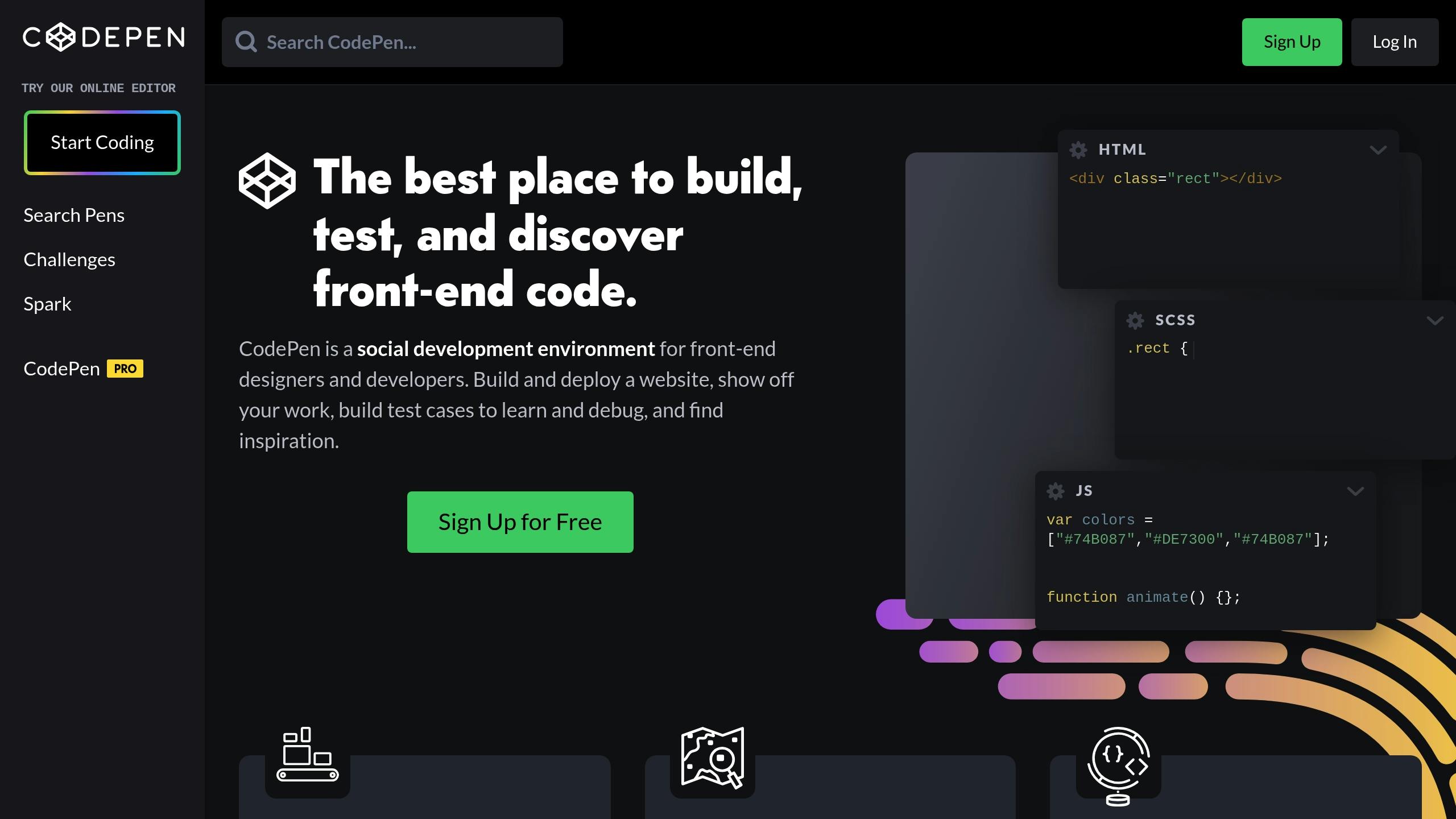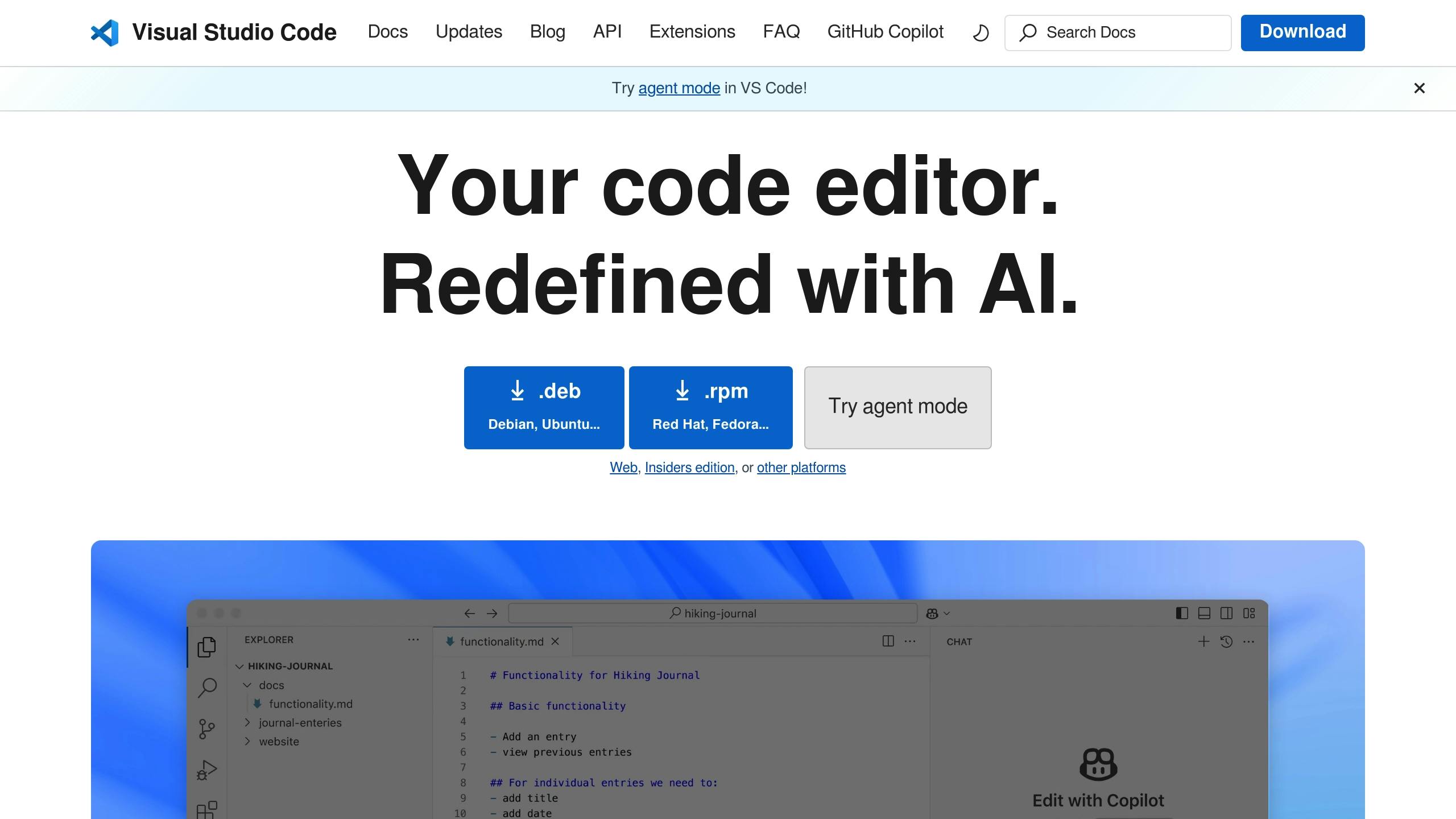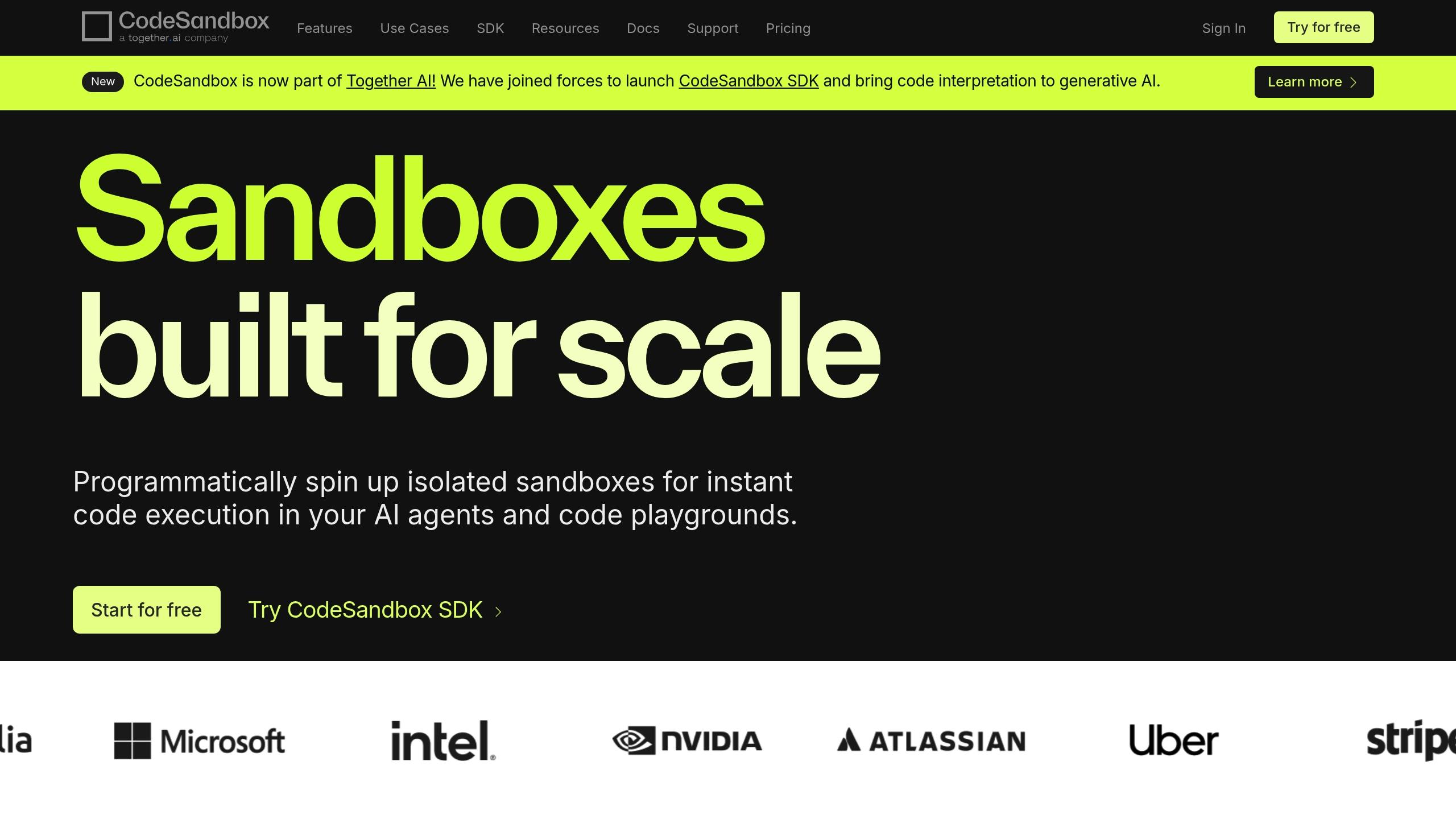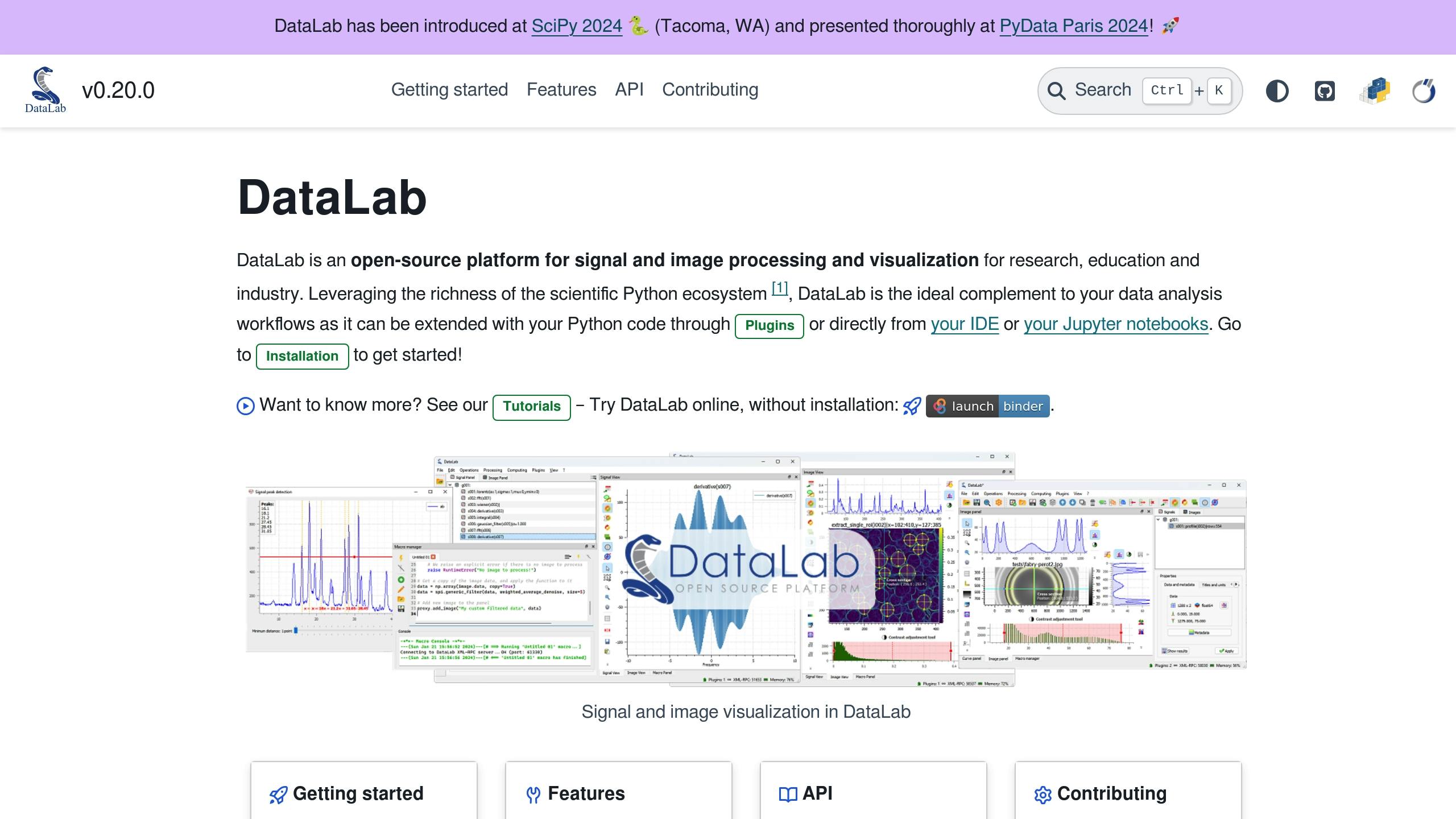
Live code sharing platforms let developers collaborate in real-time, no matter their location. These tools are essential for remote teams to write, edit, debug, and review code together. Here’s a quick look at the top 7 platforms:
-
CodePen: Best for frontend prototyping with live previews and CSS/JS testing. Free and paid plans start at $8/month.
-
Visual Studio Code Live Share: Integrates with VS Code for secure, real-time collaboration, co-debugging, and session sharing.
-
CodeSandbox: Browser-based with instant setups, GitHub integration, and classroom-friendly features. Free and Pro plans start at $9/month.
-
Codeanywhere: Cloud IDE with preconfigured containers, SSH access, and AI coding assistance. Free tier available; paid plans from $9/month.
-
GitHub Codespaces: Cloud-based development tied to GitHub repositories, offering scalable resources. Free tier includes 120 core hours/month.
-
GitLab Web IDE: Browser-based IDE with built-in merge request tools and security scanning. Available across all GitLab subscription tiers.
-
DataLab: AI-powered workspace for data science with shared notebooks and advanced collaboration. Free tier supports up to 3 users; paid plans from $25/user/month.
Quick Comparison
| Platform | Best For | Key Features | Free Tier | Paid Plans Start At |
|---|---|---|---|---|
| CodePen | Frontend prototyping | Live previews, asset hosting, debugging tools | Yes | $8/month |
| VS Code Live Share | IDE collaboration | Co-debugging, session sharing, encryption | Yes | Free |
| CodeSandbox | Browser-based coding | Instant setups, GitHub integration, classrooms | Yes | $9/month |
| Codeanywhere | Remote development | Preconfigured containers, SSH, AI assistance | Yes | $9/month |
| GitHub Codespaces | GitHub integration | Scalable resources, cloud workspaces | Yes | $0.18/hour |
| GitLab Web IDE | Code reviews | Merge tools, security scanning | Yes | $99/user/month |
| DataLab | Data science teams | Shared notebooks, AI assistant, role controls | Yes | $25/user/month |
Each platform caters to specific needs. Choose based on your team’s focus - frontend, backend, data science, or enterprise workflows.
1. CodePen

CodePen is a browser-based development environment boasting over 4 million registered users. It’s widely recognized for its ease in prototyping and sharing code, particularly for frontend projects.
One standout feature is CodePen’s Live Preview, which updates code changes instantly - no page refresh needed. This makes it a go-to tool for testing CSS animations and JavaScript interactions.
Pricing Plans
CodePen offers three pricing tiers to suit different needs:
| Plan | Monthly Cost | Key Features |
|---|---|---|
| Free | $0 | Public Pens, basic collaboration |
| Pro | $8 | Private Pens, 2GB storage, 10 projects |
| Super Pro | $12 | Team features, unlimited projects, priority support |
The platform handles an impressive 150 million monthly page views and hosts 330 million saved Pens [3]. Its features are designed to streamline frontend development:
-
Preprocessor Support: Built-in tools for Sass, Less, and modern JavaScript frameworks like React.
-
Asset Hosting: Storage options ranging from 2GB to 20GB, depending on the plan.
-
Collaboration Tools: Real-time Collab Mode for team projects.
-
Professor Mode: Tailored tools for educators.
“CodePen integrates prototyping with social coding, making it indispensable for frontend experimentation”, says Smashing Magazine.
Practical Use Case
Airbnb’s development team turned to CodePen to prototype their Date Picker component before bringing it into production. This highlights how the platform isn’t just for hobbyists - it’s a practical tool even for large-scale projects.
CodePen also fosters a strong community by offering features for educators and showcasing innovative code snippets through curated collections. For debugging, the Debug View isolates code issues, simplifying troubleshooting.
Though excellent for frontend development, CodePen doesn’t support server-side code execution, which limits its backend capabilities. Even so, it remains highly rated, with an average score of 4.7/5 on third-party review sites [1][2].
2. Visual Studio Code Live Share

Visual Studio Code Live Share brings collaborative coding directly into the IDE, making it easier for distributed teams to work together. This extension, developed by Microsoft, is a game-changer for remote collaboration.
Core Features and Performance
Live Share allows multiple users to edit code simultaneously - up to 30 participants - while keeping their individual editor settings intact. It handles large projects with over 1,000 files efficiently, thanks to its well-designed architecture.
| Feature | Capability | Performance Impact |
|---|---|---|
| Co-Debugging | Shared breakpoints with personal inspection | Minimal latency |
| Live Editing | Multi-cursor collaboration | Real-time sync |
| Session Security | End-to-end encryption (TLS 1.3) | No speed penalty |
| Resource Sharing | Terminals, servers, and processes | Host-dependent |
These features make coding sessions faster and more collaborative.
Real-World Impact
A 2023 Microsoft study found that teams using Live Share resolved bugs 40% faster than those relying on traditional screen-sharing tools. The ability to divide tasks significantly speeds up debugging and interface adjustments.
“Essential for distributed teams”, says a review from DEV Community[4].
Security and Access Control
Live Share ensures secure collaboration with several safeguards:
-
Session links expire after 12 hours, with an option for hosts to approve guest access.
-
Hosts can control editing permissions or restrict access to specific files.
-
All data transfers are encrypted using TLS 1.3.
These features make it particularly appealing for both businesses and educational institutions.
Enterprise and Education Use
Live Share has gained popularity in professional and academic settings. For example, companies like CodeSignal use it during technical interviews, allowing interviewers to observe candidates’ coding in real time while discussing logic through integrated audio chat. The platform holds a 4.4/5 rating on the VS Marketplace[5]. Additional tools can be integrated to improve design collaboration during sessions.
Setup Requirements
To get started:
-
Download and install Visual Studio Code (free).
-
Add the Live Share extension from the marketplace.
-
Log in with a Microsoft or GitHub account.
The platform is free for all users, though resource-heavy sessions may consume Azure credits.
3. CodeSandbox

CodeSandbox is a browser-based development tool designed for real-time collaboration. A 2022 platform update led to a noticeable increase in user adoption[10].
Core Collaboration Features
CodeSandbox provides two collaboration modes tailored to different needs:
| Mode | Features | Ideal For |
|---|---|---|
| Open Mode | Allows simultaneous editing with visible cursors | Pair programming |
| Classroom Mode | Presenter controls access for over 30 users | Workshops and training sessions |
The platform relies on Operational Transforms, ensuring smooth, conflict-free editing[6]. Live sessions come with end-to-end encryption and automatic session expiration for added security.
Development Environment
CodeSandbox eliminates the need for lengthy setups by offering instant, browser-based environments that support a variety of frameworks and programming languages. Its use of Firecracker microVMs ensures secure isolation, making it a reliable choice for both individual developers and enterprise teams[11].
Enterprise Solutions
For enterprise users, CodeSandbox includes features such as:
-
Branch-specific URLs for seamless repository collaboration
-
Real-time terminal sharing to aid team debugging
-
GitHub workflow integrations with pull request support
-
Role-based access controls for managing team permissions
Notably, 42% of surveyed companies use CodeSandbox for technical screenings[9]. This is made possible through features like candidate-specific Live Session URLs and real-time code observation without the need for screen sharing[9]. These tools are offered with flexible pricing options to meet various organizational needs.
Performance Considerations
While CodeSandbox works efficiently for most projects, performance can lag for projects with more than 50 files[9]. Free team accounts include 5GB of storage, which is adequate for most collaborative tasks[8].
Pricing Structure
| Plan | Monthly Cost | Storage | Key Features |
|---|---|---|---|
| Free | $0 | 5GB | Public sandboxes, basic collaboration tools |
| Pro | $9 | 20GB | Private sandboxes, version control options |
| Builder | $119 | 100GB | Advanced SDK and team-focused features |
| Enterprise | Custom | Custom | Dedicated support, single sign-on (SSO) |
CodeSandbox’s combined IDE and preview panel allows teams to onboard 83% faster by providing instant feedback during development[9].
4. Codeanywhere

Codeanywhere is a cloud-based IDE trusted by more than 2.5 million developers [18]. It focuses on remote development and real-time collaboration, making it a go-to tool for many.
Performance and Infrastructure
Codeanywhere boasts lightning-fast performance with latency under 10 ms, compared to the usual 150 ms seen in traditional VDI setups [13]. This level of responsiveness is ideal for demanding development tasks and multi-monitor workflows.
Development Environment Features
Codeanywhere simplifies remote development with several standout features:
| Feature | Description | Benefit |
|---|---|---|
| Preconfigured Containers | Quick setup for popular programming languages | Saves time on environment setup |
| SSH Terminal Access | Direct server management and shared terminal sessions | Supports collaborative debugging |
| Git Integration | Built-in version control | Simplifies workflow management |
| Dev Container Standard | Configure environments with devcontainer.json | Ensures team-wide consistency |
These tools make remote collaboration smoother while maintaining efficiency and reliability.
Collaborative Development Tools
The platform includes real-time cursor tracking, simultaneous code editing, and user-specific permissions. Pair programming and shared debugging are made easy with joint terminal access [14][15][12].
Enterprise Security
For industries with strict regulations, Codeanywhere offers advanced security options, such as air-gapped network deployments [13][18].
Resource Management
Codeanywhere’s pricing structure is designed to optimize resource usage:
| Plan | Cost/Month | Features |
|---|---|---|
| Free | $0 | 20 hrs/month, 4 workspaces |
| Personal | $9 | 150 hrs/month, 16 workspaces |
| Professional | $25 | 400 hrs/month, 30 pinned workspaces |
| Enterprise | Custom | Dedicated tenants, SSO |
Recent Updates
The platform recently added AI-powered coding assistance through Continue.dev integration [16], enhancing productivity. With a 4.1/5 rating on Capterra [19], users appreciate its remote server management capabilities and competitive pricing [17][19].
5. GitHub Codespaces

GitHub Codespaces provides cloud-based development environments tightly integrated with GitHub repositories. It simplifies on-demand development for remote teams, significantly cutting setup time. For example, GitHub reduced setup times from 45 minutes to just 5 minutes using shallow cloning and Docker caching [25].
Development Environment Features
Codespaces includes several key tools:
| Feature | Capability | Benefit |
|---|---|---|
| Cloud Workspaces | Access via browser or local IDE | Flexibility to work anywhere |
| GitHub Integration | Direct repository access | Easy version control |
| Environment Config | Customizable via devcontainer.json | Ensures uniform setups for teams |
| Compute Options | 2–32 cores, 4–64GB RAM | Scalable resources for projects |
Collaboration Tools
Codespaces enhances teamwork with features like integration with Visual Studio Live Share, enabling real-time code editing and shared debugging sessions [22]. Developers can also launch codespaces directly from pull requests, making code reviews more interactive and efficient [21].
Security and Infrastructure
GitHub Codespaces prioritizes security by running all environments in isolated containers with built-in vulnerability scanning [20]. Sessions automatically time out after 30 minutes of inactivity, and organizations can enforce access policies for added control [24]. These measures ensure both safety and efficiency during collaborative work.
Pricing and Resource Management
The pricing model is designed to suit different development needs:
| Machine Type | Hourly Rate | Storage Cost |
|---|---|---|
| 2-core | $0.18 | $0.07/GB per month |
| 4-core | $0.36 | Included |
| 8-core | $0.72 | Included |
| 16-core | $1.44 | Included |
| 32-core | $2.88 | Included |
Free-tier users get 120 core hours monthly (equivalent to 60 hours on a 2-core machine) plus 15 GB of storage [20][23].
Performance Boosts
Codespaces uses prebuilds to speed up environment creation, achieving a 95% bootstrap rate [25]. Eric J. Ma described it as a “Productivity saver for large projects”, though free-tier users may encounter some limitations [26].
Enterprise Use
Enterprise adoption of GitHub Codespaces has grown by 45% year-over-year [27]. Its ability to standardize development setups through configuration-as-code makes it especially useful for large teams handling complex workflows.
6. GitLab Web IDE

GitLab Web IDE brings coding to the browser by combining features from VS Code with GitLab’s collaboration tools. In 2022, a major update reduced memory usage by 40% while keeping full support for language server protocols [31].
Key Development Features
You can open GitLab Web IDE using the ’.’ shortcut, file browser context menus, or directly from merge requests. To improve speed, it initially loads only the 10 most-changed files, reducing load times by 35% compared to earlier versions [28].
Collaboration Tools
The IDE simplifies code reviews by integrating directly with merge requests. Developers can view side-by-side diffs, leave comments on specific lines, and stage changes - all without leaving the interface [30]. These features are backed by strong security measures and improved performance.
“We’re bridging the gap between casual contributors and core developers”, said GitLab’s VP of Product [28].
Security and Performance Highlights
| Feature | Functionality | Benefit |
|---|---|---|
| SAST Integration | Scans code for vulnerabilities | Provides real-time feedback |
| Encrypted Sessions | Secures remote coding sessions | Protects collaborative work |
| Memory Optimization | Uses 800MB per session on average | Ensures compatibility with devices |
| File Processing | Faster diff algorithms (50% quicker) | Boosts productivity |
Enterprise Applications
Large organizations have seen measurable benefits with GitLab Web IDE. Southwest Airlines uses it to streamline workflows for a team of over 1,200 developers, enabling direct production deployments. Similarly, Cube, a European tech firm, reported a 40% drop in code review times after adopting the IDE along with AI pair programming features [32].
Access and Pricing
The IDE is available across all subscription tiers - Free, Premium, and Ultimate - starting with GitLab 18.0. While core features are free, advanced tools like security scanning and custom environment templates are part of the Ultimate plan, priced at $99 per user per month [29]. For self-managed setups, GitLab 15.11 or higher is required, with the vscode_web_ide flag enabled. The IDE supports over 50 programming languages via LSP integration and includes built-in SAST scanning for languages like C/C++ (Clang), Go (Gosec), Python (Bandit), and Ruby (Brakeman) [29]. Preconfigured environments have also helped enterprise teams cut onboarding time by 30% [31].
7. DataLab

DataLab is designed to make collaborative coding effortless with its AI-powered environment for real-time editing and data analysis. Its setup allows team members to work on different parts of a project simultaneously, ensuring data stays consistent throughout. Let’s dive into its real-time collaboration features.
Real-Time Collaboration Features
DataLab provides a shared workspace similar to Google Docs, tailored for data science. It tracks changes at the cell level and allows multiple code cells to run at the same time, making teamwork smoother [34].
| Feature | Capability | Benefit |
|---|---|---|
| Resource Allocation | 16GB RAM, 8 vCPUs | Handles demanding tasks |
| Storage Capacity | 20GB per workbook | Accommodates large datasets |
| Database Connectivity | 15+ supported types | Works with various data sources |
| Team Access | Role-based permissions | Keeps collaboration secure |
Security and Integration for Enterprises
DataLab prioritizes security with SOC 2-compliant isolated workspaces and encrypted data transfers. Column-level permissions ensure team members only access data they’re authorized to view during collaborative sessions [33].
According to a DataCamp review, DataLab stands out for its smooth integration of AI-generated and manually written code [37].
Performance Results
Here’s how DataLab has made an impact:
-
Shopify saw a 60% reduction in ETL pipeline development time thanks to collaborative debugging.
-
Pfizer cut clinical trial analysis time by 42% through cross-functional teamwork [35].
-
The AI copilot feature sped up debugging by reducing the average resolution time by 37% [33].
Advanced Collaboration Tools
DataLab’s tools make teamwork even easier. Its context-aware merging ensures dataset connections stay intact during conflict resolution, while automated version control creates Git-style commits. The VOSpace storage system lets users share notebooks publicly without needing email invites [36].
The built-in AI Assistant helps with context-aware code suggestions by analyzing active cells and dataset structures. Automated code review rules ensure projects maintain high-quality standards [33].
Pricing and Resources
The free tier includes:
-
3 collaborative workbooks
-
20GB storage per workbook
-
8 vCPU computing power
-
Support for up to 3 users at a time [38]
Team plans start at $25 per user per month, offering more storage, priority support, and advanced version control. Enterprise plans include custom roles and guaranteed uptime through service-level agreements [34].
Features and Pricing Overview
The platforms reviewed earlier each bring their own strengths to the table. Here’s a quick breakdown of common features and pricing patterns you can expect.
Most platforms offer real-time collaboration, live previews, and integrated IDEs. Some focus on frontend development with instant previews, while others provide more extensive tools like real-time editing, terminal sharing, and containerized environments.
Keep in mind that system requirements - such as memory, browser compatibility, and internet speed - vary by platform. Make sure these align with your project’s technical needs before making a decision.
For enterprise users, plans often include extras like single sign-on, audit logs, custom branding, priority support, and uptime guarantees. Prioritize the features and technical capabilities that fit your workflow to find the right platform for your team.
Final Thoughts
Live code sharing platforms are quickly advancing with the integration of AI and real-time collaboration features. Gartner predicts that by 2026, 60% of coding sessions will use AI-powered tools [39]. This underscores the need to choose platforms that keep up with these advancements.
According to Stack Overflow’s 2024 survey, 68% of developers prioritize tools that integrate seamlessly with their workflows [42]. This shows how choosing the right platform can improve collaboration and productivity, especially when it aligns with your team’s specific needs.
Here’s a quick guide to matching tools with team focus:
| Team Type | Recommended Setup | Key Benefits |
|---|---|---|
| Front-end Teams | CodePen + Browser Tools | Instant previews and easy asset handling |
| Remote Teams | GitHub Codespaces | Regional servers and built-in voice/video |
| Data Science | DataLab | Jupyter support and shared notebooks |
For enterprise teams, security and compliance are critical. A 2025 JetBrains report revealed that 42% of teams face onboarding delays when adopting new platforms [40]. This highlights the importance of balancing functionality with ease of onboarding. Ensuring your tools are secure and easy to implement will help boost productivity rather than slow it down.
To further enhance live coding workflows, consider using complementary tools. For example, Hoverify provides quick CSS inspection and asset extraction, making debugging faster and more efficient.
Since 2020, enterprise adoption of collaborative coding tools has grown by 300% [39][41], showing a clear trend toward integrated development environments.
FAQs
What should I consider when selecting a live code sharing platform for my team?
When choosing a live code sharing platform, focus on what matters most to your team. Key factors include real-time collaboration tools, compatibility with the programming languages you use, ease of setup and use, and how well it integrates with your existing tools and workflow.
Take time to evaluate the platform’s features, strengths, and limitations to ensure it aligns with your team’s goals and enhances productivity.
What security features should developers look for in live code sharing platforms?
When using live code sharing platforms, it’s important to prioritize security features to protect your code and sensitive data. Look for platforms that offer end-to-end encryption to ensure your shared code cannot be intercepted by unauthorized parties. Access controls are also crucial, allowing you to set permissions for who can view or edit your code. Additionally, platforms with activity logs can help you monitor changes and detect any unauthorized access.
Always ensure the platform complies with relevant security standards and best practices to safeguard your development workflow.
Can live code sharing platforms integrate with my current tools and workflows to boost productivity?
The ability of live code sharing platforms to integrate with existing tools and workflows depends on the specific platform you choose. Many of these platforms are designed to complement popular development tools, making it easier to streamline collaboration and enhance efficiency. For example, some platforms may support integrations with code editors, project management tools, or version control systems.
To find the best fit for your needs, review the features and compatibility options offered by each platform. This ensures they align with your current development setup and productivity goals.
